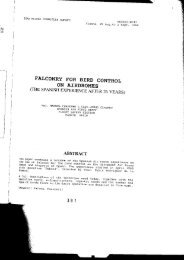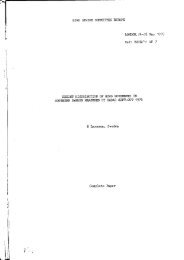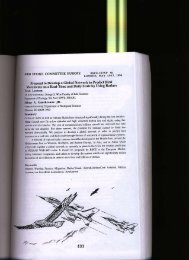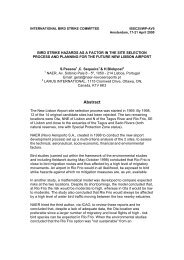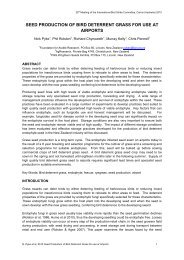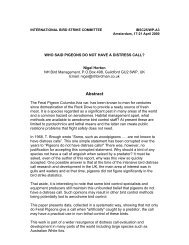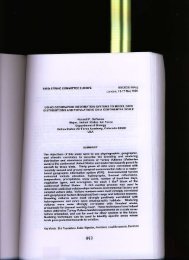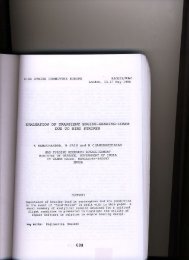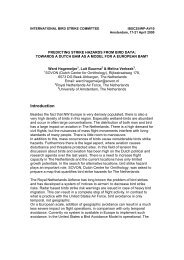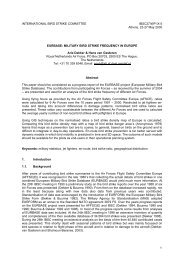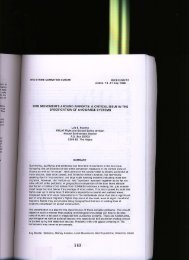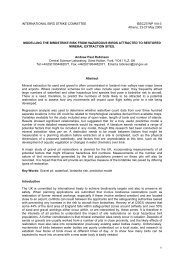Aircraft Technology - International Bird Strike Committee
Aircraft Technology - International Bird Strike Committee
Aircraft Technology - International Bird Strike Committee
- No tags were found...
You also want an ePaper? Increase the reach of your titles
YUMPU automatically turns print PDFs into web optimized ePapers that Google loves.
The leading international magazine for the manufacturing and MRO sectors of commercial aviationTESTING THE DREAM TO THE LIMIT:BOEING STILL BULLISH ABOUT 787■ BIRD-STRIKES — PREVENTING POTENTIAL DISASTER■ HOW VIDEO SYSTEMS ARE BOOSTING SECURITY■ KEEP ON RUNNING: PW4000 MAINTENANCE■ TRENDS IN SUPPLY CHAIN MANAGEMENTAugust- September 2010 Issue: 107www.ubmaviationnews.com
TECHNOLOGY & INNOVATIONPrevention is the best cureThe ditching of a US Airways A320 in New York’s Hudson River in January 2009 highlighted aworldwide safety issue: strikes of birds and other wildlife that damage aircraft. Preventing strikesis the best way to minimise the risk, reports Chris Kjelgaard.<strong>Bird</strong>strike damage to the windshield of a737-400 in September 2000.The dramatic TV pictures beamed aroundthe world on January 15, 2009 of a USAirways A320 floating down the HudsonRiver past Manhattan with more than 150 peoplestanding on its wings, brought the issue ofbird strikes into sharp focus for the entire aviationcommunity.Such spectacular incidents involving strikesof birds or other wildlife on aircraft are rare, butthey do represent a significant safety risk toaviation. According to FAA National Wildlife<strong>Strike</strong> Database (NWSD) data compiled by theWildlife Services department of the USDepartment of Agriculture’s Animal and PlantHealth Inspection Service (USDA APHIS),wildlife strikes were reported on 89,727 USregisteredaircraft in the 19 years from 1990 to2008 inclusive. Of these strikes, 87,416 — or97.4 per cent of all reported incidents —involved birds.In 10,344 wildlife strikes the aircraft wasdamaged — and birds accounted for 9,606 (or92.9 per cent) of the incidents. The only goodnews is that a bird strike is much less likely todamage an aircraft than when the aircraft hitsa large terrestrial mammal. Going by the NWSDdata, only 14-15 per cent of bird strikes damageaircraft but 59 per cent of mammal strikescreate damage, says John Weller, wildlife biologistfor the FAA’s Office of Airport Safety andStandards.Weller and Michael O’Donnell, director ofairport safety and standards for the FAA, reportthat “at no time” does the FAA regard the riskof a bird strike as “great or severe”. There are4,000 to 6,000 commercial aircraft flying atany time in the USA and between 50,000 to60,000 commercial flights a day. “We know fora fact there are 20 to 25 strikes a day,” Wellernotes. However, research by Dr RichardDolbeer, the recently retired chairman of the<strong>Bird</strong> <strong>Strike</strong> <strong>Committee</strong> USA, suggests that only30-40 per cent of bird strikes in the US arereported — “so in reality there are 40 to 50occurring per day” throughout the country, saysWeller.Worldwide, the number of bird strikes ismuch greater — but because some countriesreport incidents poorly — if at all — the scaleof the problem is not well-understood interna-52 ❙ <strong>Aircraft</strong> <strong>Technology</strong> - Issue 107 ❙
TECHNOLOGY & INNOVATIONAlaska Air Group is outfitting both the Alaska Airlines and Horizon Air fleets with a landing-light technology, and has reported reductions of 30 per centor more in bird-strike rates. However, a 737-400 Combi which hadn’t yet been fitted with the technology ingested an eagle at Sitka, Alaska on August8, at an estimated cost of $2m.<strong>Bird</strong>strike damage to to a JT8D engine.A Turkey Vulture impact on the leading edge ofa C-130 wing.tionally. <strong>Bird</strong> strikes represent “one of the mostsignificant and underrated hazards” to aviation,says John Allan, chairman of the <strong>International</strong><strong>Bird</strong> <strong>Strike</strong> <strong>Committee</strong> and head of the WildlifeManagement Programme at the UK’s Food andEnvironmental Research Agency.In the 20 years to 2008, wildlife strikeskilled more than 229 people and destroyedmore than 210 aircraft, APHIS noted in itsreport Wildlife <strong>Strike</strong>s to Civil <strong>Aircraft</strong> in theUnited States 1990-2008. “That’s at a minimumand there are a number of incidents notfully established or explained” which birdstrikes could have caused, says Allan.“Statistically, you’re slightly more likely tohave a bird strike on landing than on take-off,probably because on take-off the aircraft is gettingout of the area quicker,” comments Allan.However, bird strikes on take-off “are more dangerous”.Allan says: “The really bad ones resultfrom a catastrophic loss of power after the aircraftis in the air, immediately after take-off.That’s very much the commonest cause ofcrashes from bird strikes.”Apart from the US1549 incident, recenthigh-profile accidents involving bird strikesinclude the loss of a Kalitta Air 747-200F ontake-off at Brussels on May 25, 2008 (all fiveoccupants of the aircraft escaped with theirlives); and the loss of a Cessna 500 Citationafter take-off, killing all five on board, after theaircraft hit at least one American white pelicanwhile climbing from Wiley Post Airport atOklahoma City on March 4, 2008.An increasing risk in the USAccording to APHIS, the risks of bird strikesin the US are growing, for three reasons. One isthat populations of wildlife species commonlyinvolved in strikes have increased markedly inrecent decades because the species haveadapted to living in urban environments, includingairports. From 1980 to 2007, for instance,the resident, non-migratory population ofCanada geese — the bird species that US1549struck — in the US and Canada increased fromone to four million. “Those geese have modifiedtheir behavior to become tolerant of humanbehavior,” says Weller. “The same goes forgulls. Once a species is tolerant, it’s very difficultto remove them from the airport environment.”A second reason is that the nation’s commercialair traffic is growing. It increasedfrom 18 million aircraft movements in 1980to 28 million in 2008, and the FAA predictsUS commercial air traffic will grow to 35 millionmovements annually by 2025. Thirdly,today’s commercial jets are much quieterthan in the past and most have only twoengines. Research has shown that, likehumans, birds and other animals apparentlycan’t hear today’s jets coming. If a twinengineaircraft suffers a two-engine inges-54 ❙ <strong>Aircraft</strong> <strong>Technology</strong> - Issue 107 ❙
TECHNOLOGY & INNOVATIONtion, it is more likely to have difficulties thana three- or four-engine jet.While today’s high-bypass turbofans aremuch more efficient than earlier engines, theyalso have larger intakes. “The reality of that isthat it increases the frontal area of the engine,giving greater exposure to birds and FOD [foreignobject debris],” notes Roger Nicholson,associate technical fellow in aviation safety atBoeing Commercial Airplanes. While incidentdata shows that tail-mounted engines — suchas those in the DC-10 and MD-11 — have“slightly decreased rates of bird ingestion”because they receive some protection from theaircraft’s wings, “it’s more an issue of thefrontal area of the engine and less of its location,”he says.Engines aren’t the only parts of aircraftdamaged by bird strikes. Nose radomes, flightdeckwindscreens and the leading edges of aircraftwings and empennage are all particularlysusceptible to bird strikes, as are loweredundercarriages. Damage in any of these areasis important, as it can affect the aircraft’s flyingqualities and its ability to maintain direction.However, “engines seem to get hit slightlymore than you’d expect from their surface area,perhaps because ingestions are more likely tobe spotted” than bird strikes elsewhere, saysAllan. On large aircraft with big engines, theconcern is that the aircraft hits a flock ofmedium-sized or large birds, swamping theengines’ ability to handle ingestions and causingsubstantial power loss.Aviation authorities and manufacturers areacutely aware of the risks that bird strikes poseto aircraft and their engines. Six sections of theUS Federal Aviation Regulations — coveringbird-strike damage tolerance for engines,impact resistance for airframe structures, andprotection of airspeed indication — impose“voluminous” technical requirements on a commercialaircraft’s ability to withstand birdstrikes, says Nicholson.“The current rules require testing at verysevere combinations of aircraft speed, fan rotorspeed, bird numbers and strike location, yieldingan extremely conservative test for the birdsizes required,” says the FAA. “This conservatismprovides a safety margin that allows anengine to safely ingest birds larger thanrequired for the conditions typically seen.”Additionally, Boeing imposes on its designs“hundreds of proprietary requirements” inAn avian radar installation at SeaTac<strong>International</strong> Airport.❙ <strong>Aircraft</strong> <strong>Technology</strong> - Issue 107 ❙ 55
TECHNOLOGY & INNOVATIONthe FAA, which helps it use the data gatheredto create a wildlife mitigation plan that takesinto account considerations such as habitatmodification.According to O’Donnell, the FAA now has“rulemaking in progress” to make wildlife hazardassessments compulsory for all US commercial-serviceairports, whether or not theyhave suffered any damaging or multiple wildlifestrikes.Other mitigation methodsAnother means of mitigation is movingwetlands — major attractants for waterfowlspecies and other large birds — off the airportproperty to many miles away in the samewatershed. The US government ran a programmeuntil recently which financiallyencouraged wetland creation on airportlands, so the idea of moving wetlands awayhas created difficulties. Now, however, amulti-agency agreement which includesamong its signatories the US Army Corps ofEngineers, which manages the country’s wetland-creation,is easing the problem. In manycases, the wetland the airport creates elsewherein the watershed is much bigger thanthe on-airport area which it could have madeinto a wetland.Stage two of managing wildlife hazards onthe airport is using trained personnel to scarebirds, using equipment such as propane cannons,pyrotechnics, firecrackers and otheracoustic and visual means. Some lighting techniquesmay prove efficacious, says Weller. Evenscarecrows and fluttering banners can have aneffect.While potentially controversial if not usedproperly, lasers can be effective in keepingbirds away from airports at dusk and at night.<strong>Bird</strong>s see a kilometer-long green stick movingabove them and this makes them uneasy.Some airports in the south of France use “laserlighthouses” which are about a meter high androtate continuously, sweeping a beam thatfrightens birds on the ground without blindingpilots or the birds themselves. Eventually birdsget fed up with the laser and fly off elsewhere.Another method used in Europe is falconry,a favourite with Spanish airports. This is effective,but requires highly trained staff and expensivefalconry mews; and the falconsthemselves can (and have been known to) beingested into aircraft engines themselves when❙ <strong>Aircraft</strong> <strong>Technology</strong> - Issue 107 ❙ 57
TECHNOLOGY & INNOVATIONAccipiter Radar has developed avian radars from marine radars to detect birds on or near airports.The first thing, and whatairports tend to do least well,is getting rid of things thatattract birds in the first place.—John Allan, chairman,<strong>International</strong> <strong>Bird</strong> <strong>Strike</strong><strong>Committee</strong>unleashed in pursuit of their prey. Also cominginto vogue is the use of dogs to scare off birds,but unleashed dogs pose a similar hazard. InItaly, a company has developed a radio-controlled,flying model of a large bird of prey toscare off birds. “The jury is still out,” remarksAllan.The third stage of wildlife hazard managementis non-lethal (or occasionally lethal)removal of bird and animal species. In the US,the airport needs a state depredation permitfor non-threatened species and federal relocationpermits for migratory or threatenedspecies. In the US, 90 per cent of all birds aremigratory, “so it behooves airports to havethem in their possession,” says Weller. “It alsobehooves the airport to have an associatedwildlife biologist.”Avian radars and pulsing landinglightsCompanies such as Accipiter Radar, DeTectand TNO have developed avian radars frommarine radars to detect birds on or near airports.Avian radars have been installed atSeaTac, Chicago O’Hare, JFK and Dallas/FortWorth. Weller, O’Donnell and Allan concur thatsuch radars can be very helpful in allowing airportbiologists to establish daily and seasonalpatterns of bird movement, alerting the biologistswhere major bird-attractants are locatedin the vicinity of the airport and showing migrationpathways. This provides information forhazard-mitigation efforts.“They are extraordinarily useful for gettingdata over big areas, and continuously, and particularlyat night and in fog,” says Allan. “Thedownside is, most won’t tell you what sort ofbird it is, and they can’t really differentiatethree small birds from one big one.”While avian radars are very good for spottinglarge flocks, two problems are interpretingthe radar returns and how the airport can usethe information the returns provide. Air trafficcontrollers in the tower can be informed thatbirds are on or near the airport, but by the timethey are told, the birds are likely to havemoved.Today’s avian radars also cannot establishthe exact three-dimensional positions of birdsaccurately enough to allow controllers to makereal-time, hold-or-go decisions. For the 360-degree coverage required, continuously rotatingmulti-beam, multiple-dish radars are neededrather than static arrays. One reason suchtechnology isn’t currently available in an avianradar is because “that makes it a weaponsaimingdevice”, comments Allan. But when the58 ❙ <strong>Aircraft</strong> <strong>Technology</strong> - Issue 107 ❙
TECHNOLOGY & INNOVATIONtechnology allows, “the next step might be ATCfor birds — having a ‘bird screen’ in the tower,”he says.One promising technology for bird-strike preventionis the use of pulsing landing lights onaircraft. Research suggests birds see thechanges in colour as the light pulses, andbecause the light never actually goes out, atnight the birds have a positional frame of referencethat helps them avoid the oncoming aircraft.Boeing isn’t yet convinced that the techniqueis helpful enough for it to install pulsinglanding lights in new aircraft. “The data isa little bit inconclusive and it’s very speciesspecific,”says Nicholson. Nevertheless,Oregon-based Precise Flight is winning convertsfor its ‘Pulselite’ landing-light technology.Qantas (which has fitted its Q300,737-400 and 737-800 fleets with Pulselite)and Alaska Air Group (which is outfitting boththe Alaska Airlines and Horizon Air fleets)report reductions of 30 per cent or more inbird-strike rates after installing the technology.By running aircraft landing lights at lesspower than normal, the technology alsoincreases landing-light life by up to 500 percent. Other major airlines are in talks withPrecise Flight.“The biggest cost drivers for an airline aredelayed or cancelled flights,” says PreciseFlight’s Charlie Babb. “If the airline has five cancelledflights [as a result of bird strikes], the costof Pulselite pretty much works out.” Installationon a 737 fleet costs less than $10,000 per aircraft,including all parts and labour, he says.Unfortunately for Alaska Airlines, a 737-400Combi which hadn’t yet had a Pulselite controllerinstalled ingested an eagle at Sitka,Alaska on August 8. The airline had to ferry ina replacement aircraft and another engine, andthe incident is estimated to have cost it $2m.Research performed by Allan in 2000 suggestedthat bird strikes cost the global airlineindustry $1.2-$1.5bn a year. His estimate wasbased on data from the US, where bird strikecontrol and reporting is very good — but itisn’t as good in some other parts of the world.Allan says: “The true figure might be muchhigher for the world as a whole. It would besafe to say that $1.2bn is a minimum estimate.”That makes bird strikes an importantcommercial problem for airlines as well as asafety issue.■Oregon-based Precise Flight has won orders forits ‘Pulselite’ landing-light technology fromQantas and Alaska Air Group.QUESTION:How can you reach the desktops of circa 20,000aviation professionals, each and every working day?ANSWER:By promoting online with us in the Aviation IndustryeNewsletter.QUESTION:How can you attract hundreds of direct click-throughsand page impressions per month?ANSWER:By promoting online with us in the Aviation IndustryeNewsletter.Call us for a personal demo:WichiTech Industries, Inc.(800) 776-4277 ● www.wichitech.com(410) 244-1966 ● FAX (410) 244-19681120 N. Charles Street, Suite 103,Baltimore, MD 21201, USABOOK YOUR BANNER ADVERTISING SPACE NOWand get bonus banner advertising space on our website!For online sales opportunities please contact:Simon Barker, Alan Samuel or Anthony Smith onTel: +44 (0) 207 579 4845/4846/4875simon.barker@ubmaviation.com or alan.samuel@ubmaviation.comor anthony.smith@ubmaviation.com❙ <strong>Aircraft</strong> <strong>Technology</strong> - Issue 107 ❙ 59



